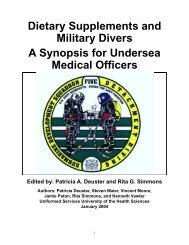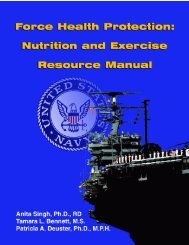Traumatic Brain Injury and Effects of Altitude - Human Performance ...
Traumatic Brain Injury and Effects of Altitude - Human Performance ...
Traumatic Brain Injury and Effects of Altitude - Human Performance ...
Create successful ePaper yourself
Turn your PDF publications into a flip-book with our unique Google optimized e-Paper software.
<strong>Traumatic</strong> <strong>Brain</strong> <strong>Injury</strong> (TBI) <strong>and</strong> <strong>Effects</strong> <strong>of</strong> <strong>Altitude</strong>:An Analysis <strong>of</strong> the Literaturewith AMS affecting more than four out <strong>of</strong> five individuals who fly directly to above 3800 meters (about12, 500 feet) (Basnyat & Murdoch, 2003).Individuals who develop symptoms <strong>of</strong> AMS should not ascend further, <strong>and</strong> should descend if theirsymptoms worsen or fail to improve. Immediate descent is critical if cerebral or pulmonary symptomsappear. Supplemental oxygen may help to relieve AMS symptoms.High-altitude cerebral edema (HACE) is relatively unusual, with prevalence estimated at between 0.5%<strong>and</strong> 4.0% <strong>of</strong> individuals who climb to altitudes above 2500 meters (8000 feet). However, because theprecise pathophysiology <strong>of</strong> neither syndrome is fully understood <strong>and</strong> because the incidence <strong>of</strong> HACE isdramatically less than that <strong>of</strong> AMS, it is not clear that the two syndromes reflect identical processes orvulnerabilities. Signs <strong>and</strong> symptoms <strong>of</strong> HACE may include dizziness, intense weakness, tingling, ataxia,altered consciousness, papilloedema (optic disc swelling), retinal hemorrhages <strong>and</strong> focal neurologicaldeficits. These symptoms can develop very quickly <strong>and</strong> are potentially fatal. As symptoms develop, thetime to loss <strong>of</strong> consciousness may be as little as 1-10 minutes (Clarke, 2006). Treatment requiresimmediate descent <strong>and</strong> oxygen supplementation. If HACE is not promptly managed <strong>and</strong> relieved, it canlead to brain herniation, coma, <strong>and</strong> death. Because HACE is usually preceded by AMS symptoms, it is<strong>of</strong>ten regarded as the “end stage” <strong>of</strong> AMS.The precise pathophysiological bases <strong>of</strong> AMS <strong>and</strong> HACE are not known, <strong>and</strong> are difficult to ascertainpartly due to individual differences. When these syndromes occur, they appear to follow from a series<strong>of</strong> systemic <strong>and</strong> cerebral changes that may involve increased cerebral blood flow (due to hypoxia)<strong>and</strong>/or vasogenic edema, both <strong>of</strong> which can cause to brain swelling <strong>and</strong> raised ICP (see Figure 3, below).Vasogenic edema has been observed in cases <strong>of</strong> moderate to severe AMS <strong>and</strong> HACE, perhaps due todisruption <strong>of</strong> BBB permeability. These <strong>and</strong> related hypotheses are the focus <strong>of</strong> continuing research,analysis, <strong>and</strong> review (Basnyat & Murdoch, 2003; Hackett, 1999a, 1999b; Hackett & Roach, 2001; Roach& Hackett, 2001; West, 2004; Wilson et al., 2009).Treatment with dexamethasone (anti-inflammatory steroid) is sometimes recommended to treat HACE(Schoene, 2005). However, recent clinical research suggests that steroids have no clear beneficial effecton TBI <strong>and</strong> may even have deleterious effects; therefore, steroids are NOT recommended for reducingICP in individuals who have sustained traumatic brain injury (TBI) (Bullock & Povlishock, 2007). Otherpharmacotherapeutic options for the prevention <strong>and</strong> treatment <strong>of</strong> altitude-related illnesses in otherwisehealthy individuals are reviewed elsewhere (Wilson et al., 2009; Wright et al., 2008).A third altitude-related illness is known as high-altitude pulmonary edema (HAPE), which usuallypresents in the first 24-48 hours after arrival at altitudes higher than 2500 meters (approximately 8000feet). HAPE may or may not follow AMS, but <strong>of</strong>ten co-occurs with signs <strong>of</strong> HACE. HAPE is a cardiopulmonarysyndrome that usually appears first as dyspnea (shortness <strong>of</strong> breath) <strong>and</strong> reduced tolerance forexercise. This can lead to dry cough (which can later become productive), tachypnea (rapid breathing),tachycardia (rapid heart rate) <strong>and</strong> fever. Cold is a risk factor for HAPE. HAPE is more common in menthan in women, <strong>and</strong> in individuals with pre-existing cardiopulmonary circulation abnormalities. Again,descent <strong>and</strong> supplemental oxygen are the recommended treatments.September 14, 2010 10



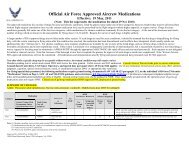
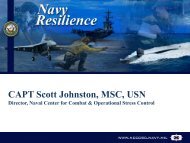
![Body Composition and Military [PDF] - Human Performance ...](https://img.yumpu.com/43269347/1/190x245/body-composition-and-military-pdf-human-performance-.jpg?quality=85)
![Tips for Grocery Shopping [PDF]](https://img.yumpu.com/37447379/1/190x245/tips-for-grocery-shopping-pdf.jpg?quality=85)
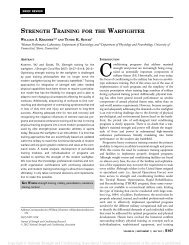
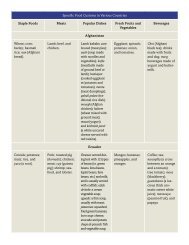
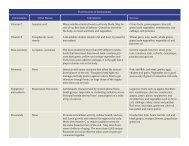
![Synthetic Drugs [PDF] - Human Performance Resource Center](https://img.yumpu.com/37447322/1/190x245/synthetic-drugs-pdf-human-performance-resource-center.jpg?quality=85)
